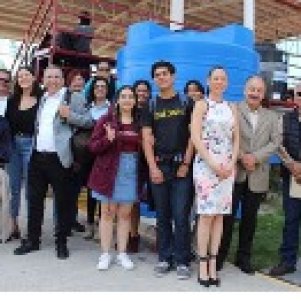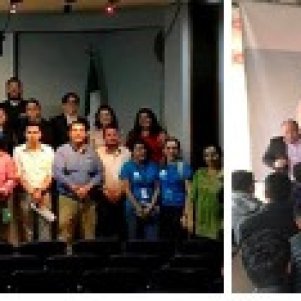Rainwater Harvesting in Guadalajara, Mexico
.jpg)
Flooding Challenges in Guadalajara
For several decades, the city of Guadalajara has been facing increasing flooding problems. Ever more hard paving in the urban areas prevents the infiltration of rainwater into the subsoil. As a result, water rushes to the drains during a shower and exceeds the capacity of the existing, old drainage systems, causing flooding. The solutions applied so far have focused on the construction of larger drains that divert water towards the Barranca de Huentitán, a canyon on the northeast side of Guadalajara. However, these measures have caused both economic and social losses. Figure 1 shows the change in land use, where permeable areas have been replaced by concrete, leaving only a few green and infiltration zones.
Water Scarcity Amidst Abundance
Counterintuitively, despite the abundance of water during each rainy season, water scarcity has increased, leaving several communities in the city without supply. This situation has led to a lot of irritation among municipal departments, affected households, and community groups, as they see no solution to the problems of flooding and water scarcity.
Research and Initiatives
To help solve this puzzle, the University of Guadalajara (UG) initiated a line of research in 2003 on the capture and use of rainwater to identify technologies to overcome this problem. This research led UG researchers to become members of the International Rainwater Catchment Systems Association (IRCSA) and, later, the American Rainwater Catchment Systems Association (ARCSA). As a result, knowledge applied to the Mexican and Latin American context was generated and developed.
Implementation of Rainwater Harvesting Systems
The results of the research during these 21 years led to the installation of several Rainwater Harvesting Systems (RWH) in homes and buildings of the university, as well as the publication of the experiences in Spanish and English. Through demonstration of proof of the RWH concept and tireless promotional work, the Government of Jalisco set up a program called “Rain Nests” and a program at the UG called “Clouds in the Sky”.
Figure 2 shows the installation of RWH in low-income housing, financed by the Government of Jalisco. Figure 3 shows the RWH installed in university buildings.
Formation of AMSCALL
These rainwater harvesting activities strengthened the promotion and understanding of the utility of the collection of rain. It also garnered interest from other rainwater harvesting practitioners in Mexico, leading to the foundation of the Asociación Mexicana de Sistemas de Captación de Agua de Lluvia (AMSCALL) in 2017, with the international support and backing of IRCSA and ARCSA. AMSCALL has so far organized two national congresses in Guadalajara in 2017 and in Morelia in 2019. The third congress is scheduled for 2025. Figure 4 shows photographs of the first and second congress.
Certification Program for Professionals
The close technical collaboration with ARCSA and the support of the university has, in the last 3 years, led to the creation of the “Certification Program to accredit professionals in rainwater harvesting and use”. The program can be followed online and sometimes in person. Four courses are currently taught:
- Course 1: Develops the concept and shares basic knowledge of RWH to enable the student to become a promoter of RWH and its technology.
- Course 2: Teaches methodologies to design RWH at a preliminary project level that can be evaluated from a technical, economic, and social point of view.
- Course 3: Trains the student in the specific development of each component of the system to define the full project for implementation.
- Course 4: Discusses the technical, regulatory, and administrative supervision methodologies for the installation of the system, as well as guidance for preparing an operation manual and system maintenance plan.
Figure 5 shows the digital propaganda of the program. The courses have attracted participants from Mexico and Latin America.
Future Challenges and Opportunities
After more than 20 years of hard and collaborative work, the future looks challenging for our team. Floods tend to increase due to persistent unplanned urbanization, while water scarcity due to drought is growing in several parts of Mexico. Still, interest in the implementation of RWH is growing. Better use of rainwater, application of techniques, and solutions to retain more water in the landscape in ponds and through managed infiltration recharge will reduce flooding and seasonal scarcity. To meet these challenges, efforts must be redoubled to promote rainwater harvesting to planners, make it part of national policy, and ensure more trained specialists who can design, develop and install more systems for homes and institutions, cities, and ecosystems.
Conclusion
It is expected that with the growing implementation of RWH systems in Mexico, professional practice will become more experienced and versatile. Specialization and international exchanges will lead to the creation of national technical standards that can drive change in managing rain in cities and buildings, enhancing sustainability and creating healthier, climate-adapted living.
About the Author
Dr. Arturo Gleason is a professor at the Department of Architecture and Urbanism of the University of Guadalajara. He is currently undertaking a short research project at the Technical University of Berlin, focusing on integrated management of rainwater in Berlin City.
Figure 1 Guadalajara municipal area (source: AMRWH 2024)
Figure 2 Rain Nests programme (Source: Government of Jalisco)
Figure 3 UG Clouds in the Sky research team
Figure 4 AMSCALL Conferences 2017 and 2019
Figure 5 Certification program to accredit professionals in the collection and use of rainwater (Source AMSCALL 2023)
.jpg)
.jpg)


.jpg)